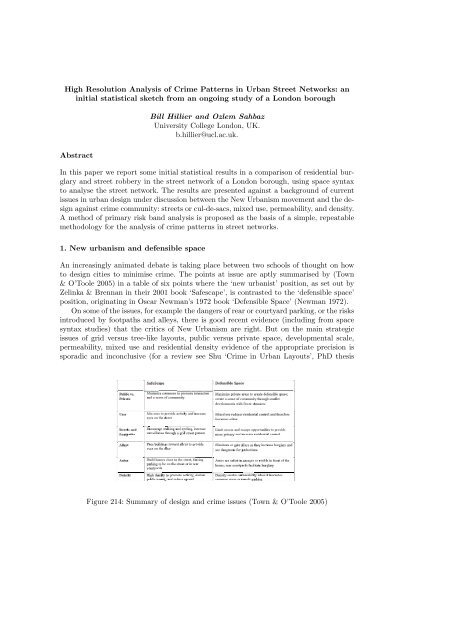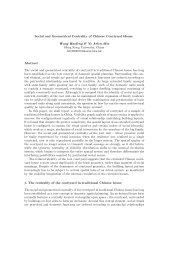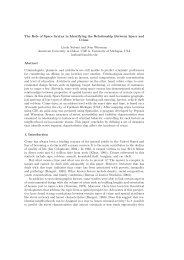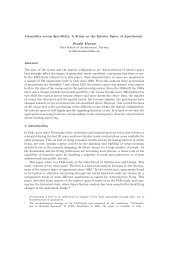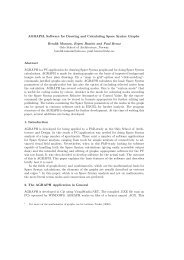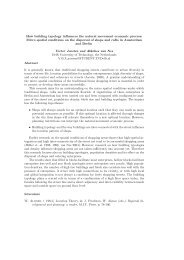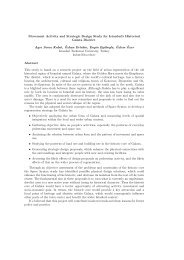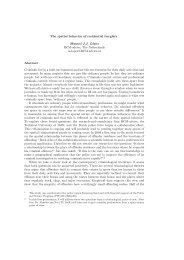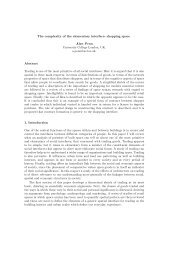High Resolution Analysis of Crime Patterns in Urban Street Networks
High Resolution Analysis of Crime Patterns in Urban Street Networks
High Resolution Analysis of Crime Patterns in Urban Street Networks
You also want an ePaper? Increase the reach of your titles
YUMPU automatically turns print PDFs into web optimized ePapers that Google loves.
452 B. Hillier and O. SahbazUniversity <strong>of</strong> London 2000). What is needed is high resolution analysis <strong>of</strong> crime patterns<strong>in</strong> urban street networks <strong>in</strong> which these issues are variables to beg<strong>in</strong> to build the body <strong>of</strong>evidence needed to decide these issues. In this paper we propose such a high resolutiontechnique. The unit <strong>of</strong> analysis is the segment <strong>of</strong> a street between junctions, and thetechnique comb<strong>in</strong>es space syntax analysis with Geographical Information Systems (GIS).In contrast to most available crime analysis packages, which focus on the cluster<strong>in</strong>g<strong>of</strong> crime <strong>in</strong> particular locations, space syntax research has po<strong>in</strong>ted to the importance <strong>of</strong>look<strong>in</strong>g at non-clustered patterns, that is the k<strong>in</strong>ds <strong>of</strong> locations <strong>in</strong> which certa<strong>in</strong> k<strong>in</strong>ds<strong>of</strong> crime occurred, but which are dispersed throughout the grid and so do not appear asclusters or ‘hot-spots’. By comb<strong>in</strong><strong>in</strong>g space syntax with the data handl<strong>in</strong>g capabilities <strong>of</strong>GIS, a flexible method <strong>of</strong> analysis can be developed which works at the high resolutionlevel required, but can also work at higher levels <strong>of</strong> aggregation such as the Output Area<strong>of</strong> the 2001 Census or the adm<strong>in</strong>istrative divisions <strong>in</strong>to wards.Previous space syntax studies have confirmed some <strong>of</strong> the pr<strong>in</strong>ciples <strong>of</strong> the prevail<strong>in</strong>gdefensible space orthodoxy, but has also opened up a positive w<strong>in</strong>dow on certa<strong>in</strong> newurbanist propositions. For example, syntax studies <strong>of</strong> residential burglary have confirmedthat when embedded <strong>in</strong> an urban street network, simple l<strong>in</strong>ear cul-de-sacs can <strong>of</strong>ten bethe safest places, but that when the cul-de-sac is generalised <strong>in</strong>to a design pr<strong>in</strong>ciple sothat whole areas take the form <strong>of</strong> a hierarchy <strong>of</strong> cul-de-sacs, the effects can be quite theopposite (Hillier and Shu 2000, Hillier 2004). It has also shown that <strong>in</strong> residential areas,the streets that are most <strong>in</strong>tegrated - and therefore with more natural movement- are<strong>of</strong>ten safer than the more broken up spaces, but that where <strong>in</strong>tegrated streets have ‘localvulnerability’; for example through ‘secondary exposure’ through alleys or adjacent openareas, or basement access, then <strong>in</strong>tegrated streets can become s<strong>in</strong>gularly vulnerable. Wecall these switches ‘flip over effects’ to express the idea that design variables do not act<strong>in</strong>dependently, but <strong>in</strong>teract, so that all must be got right together if there is to be agenu<strong>in</strong>e reduction <strong>in</strong> vulnerability. Equally complex results have come from look<strong>in</strong>g atcrimes aga<strong>in</strong>st the person <strong>in</strong> urban areas, with patterns <strong>of</strong> crime shift<strong>in</strong>g with time <strong>of</strong> dayand thus with the presence <strong>of</strong> greater or lesser degrees <strong>of</strong> movement (Alford 1996).But space syntax has not so far studied patterns <strong>of</strong> crime either at the much largerscales <strong>of</strong> the city and its multiplicity <strong>of</strong> socially and spatially differentiated areas, or with afull analysis at the high resolution level <strong>of</strong> the street segment. In this paper we seek remedythis deficiency by report<strong>in</strong>g the first results <strong>of</strong> a space syntax study <strong>of</strong> crime <strong>in</strong> the streetnetwork <strong>of</strong> an entire London borough, with 99,991 households and 263,464 people with<strong>in</strong>its boundaries (accord<strong>in</strong>g to Census 2001). We have been given access to a 5 year crimedata base <strong>in</strong> which every crime has been located and by l<strong>in</strong>k<strong>in</strong>g this to a space syntaxanalysis <strong>of</strong> the whole borough (<strong>in</strong> the context <strong>of</strong> its urban surround<strong>in</strong>gs), and l<strong>in</strong>k<strong>in</strong>g bothto social and demographics data available from the 2001 census, as well as the Borough’sown property database, we have perhaps the largest and best body <strong>of</strong> spatial, sociodemographicsand crime data yet brought together <strong>in</strong> a s<strong>in</strong>gle study. As an extra bonus,the fact that the London borough <strong>in</strong> question is largely made up <strong>of</strong> traditional hous<strong>in</strong>gon a street network, makes this data base ideal for pos<strong>in</strong>g the key current questions as tohow street networks and their function<strong>in</strong>g shape the pattern <strong>of</strong> crime. But we should alsoissue a ‘health warn<strong>in</strong>g’. The London borough <strong>in</strong> question is socially and ethnically highlyvaried, and differentiated physically between its <strong>in</strong>ner, more ‘<strong>in</strong>ner city’, and outer, moresuburban, areas. Some <strong>of</strong> its centres are already known as high crime areas. We should becareful not to generalise its results prematurely, before a range <strong>of</strong> such studies have beenmade <strong>in</strong> different cities.
<strong>High</strong> <strong>Resolution</strong> <strong>Analysis</strong> <strong>of</strong> <strong>Crime</strong> <strong>Patterns</strong> <strong>in</strong> <strong>Urban</strong> <strong>Street</strong> <strong>Networks</strong>: an <strong>in</strong>itialstatistical sketch from an ongo<strong>in</strong>g study <strong>of</strong> a London borough 453Figure 215: Newman’s Hierarchy image.2. Theoretical background: the other side <strong>of</strong> NewmanThe key issue <strong>in</strong> the debate between new urbanism and defensible space is the relationbetween the dwell<strong>in</strong>g and the public realm. Throughout the history <strong>of</strong> urbanism, thisrelation has been more or less direct, and it would not be an exaggeration to say that thevery basis <strong>of</strong> urban form historically is dwell<strong>in</strong>gs open<strong>in</strong>g on to l<strong>in</strong>ear spaces l<strong>in</strong>ked <strong>in</strong>tonetwork: the street network. In modern times, this relation has been broken twice: firstby architectural modernism, especially <strong>in</strong> its social hous<strong>in</strong>g programmes (for a review seeHillier 1988); and then by Oscar Newman’s hugely <strong>in</strong>fluential ‘defensible space’ concept,as summarised <strong>in</strong> figure 215, redrawn from page 9 <strong>of</strong> his book:But <strong>in</strong> spite <strong>of</strong> the fact that his concept radically disrupts the dwell<strong>in</strong>g-street relation,throughout his book, when talk<strong>in</strong>g about real cities, Newman aga<strong>in</strong> and aga<strong>in</strong> acknowledgesthe security benefits <strong>of</strong> well-designed streets with dwell<strong>in</strong>gs open<strong>in</strong>g on to them:‘...streets provide security <strong>in</strong> the form <strong>of</strong> prom<strong>in</strong>ent paths for concentrated pedestrianand vehicular movement’ (op. cit p. 25)....‘the street pattern , with its constant flow <strong>of</strong>vehicular and pedestrian traffic, does provide an element <strong>of</strong> safety for every dwell<strong>in</strong>g unit’(p. 103). He criticises the modernist practice <strong>of</strong> clos<strong>in</strong>g <strong>of</strong>f streets the make larger urbanblocks, not<strong>in</strong>g that ‘An <strong>in</strong>habitant return<strong>in</strong>g home must leave the public street and w<strong>in</strong>dhis way through the undef<strong>in</strong>ed and anonymous grounds <strong>of</strong> the project to reach the frontdoor <strong>of</strong> the build<strong>in</strong>g. He would have been much safer had he been able to go directly fromstreet to front door, and safer still if the front door and lobby <strong>of</strong> his build<strong>in</strong>g faced directlyonto the street’(p. 25). Later he adds: ‘The <strong>in</strong>terior <strong>of</strong> project build<strong>in</strong>gs and grounds sufferthe unique dist<strong>in</strong>ction <strong>of</strong> be<strong>in</strong>g public <strong>in</strong> nature and yet hidden from public view’ (p.32) and later still: ‘Large super-blocks, at various densities, have been found to exhibitsystematically higher crime rates than projects <strong>of</strong> comparable size and density that havecity streets cont<strong>in</strong>u<strong>in</strong>g through them’. There is also the reverse effect, that Newman acknowledges:that dwell<strong>in</strong>g entrances on the street benefits the street and makes it moresecure: ‘The street comes under surveillance from the build<strong>in</strong>g, the build<strong>in</strong>g entries andlobbies under the surveillance <strong>of</strong> the street’ (p. 15) ‘The position<strong>in</strong>g <strong>of</strong> front entrancesalong the street provides them with cont<strong>in</strong>uous natural supervision by passers by; the residentswith<strong>in</strong> their houses, <strong>in</strong> turn, provide these passer-by with protective surveillance’.There is also a polic<strong>in</strong>g benefit: ‘Well lit front door paths, with <strong>in</strong>dividual lights over the
454 B. Hillier and O. Sahbazentrances, allow cruis<strong>in</strong>g police to spot at a glance any peculiar activity tak<strong>in</strong>g place on arow-street house’. And more generally: ‘The street, without the cont<strong>in</strong>ued presence <strong>of</strong> thecitizen, will never be made to function safely for him’ (p. 15).One might then ask why Newman to universalise his defensible space concept. Severalfactors seem to have been <strong>in</strong>volved. First, Newman’s object <strong>of</strong> concern was not the city asa whole but the socially disastrous social hous<strong>in</strong>g estates that had been <strong>in</strong>serted <strong>in</strong> decadesfollow<strong>in</strong>g the two post-second world war. Second, the idea <strong>of</strong> hierarchically ordered spacewas at the time the prevail<strong>in</strong>g architectural orthodox, taught <strong>in</strong> architecture schools underthe rubric <strong>of</strong> the need for a ‘hierarchy <strong>of</strong> space from public to private’, which seemed tobe confirmed by the then fashionable, though now largely discarded, ‘theory <strong>of</strong> humanterritoriality’ (Hillier & Hanson 1984). Newman also thought we might need to movetowards a city <strong>of</strong> hierarchically ordered enclaves as a k<strong>in</strong>d <strong>of</strong> spatial counterweight towhat he saw as the <strong>in</strong>creas<strong>in</strong>g openness, liberality and moral heterogeneity <strong>of</strong> modernsocieties, which he thought had dim<strong>in</strong>ished our powers to act as communities and <strong>in</strong>hibitcrime.Whatever the reasons, the problem situation has now changed. We are no longer preoccupiedwith the need to fix past architectural errors, but to learn to design cities aga<strong>in</strong>.The ‘other side <strong>of</strong> Newman’, and how we l<strong>in</strong>k residential areas together to form a wellwork<strong>in</strong>gand secure system, is a key part <strong>of</strong> this agenda. The aim <strong>of</strong> this paper is to openup research on this ‘other side <strong>of</strong> Newman’ from the po<strong>in</strong>t <strong>of</strong> view <strong>of</strong> urban security, and tobeg<strong>in</strong> to ask how far his many observations on the security benefits <strong>of</strong> well-work<strong>in</strong>g streetnetworks can be supported by evidence. We also have the methodological aim <strong>of</strong> sett<strong>in</strong>gup simple and repeatable space syntax based methods <strong>of</strong> analysis for crime patterns <strong>in</strong>street networks, so that evidence can be accumulated on a consistent basis.3. Redef<strong>in</strong><strong>in</strong>g the urban crime problemUnderstand<strong>in</strong>g the relation between the urban street network and crime is not simply amatter <strong>of</strong> measur<strong>in</strong>g properties <strong>of</strong> the street network and correlat<strong>in</strong>g them with levels <strong>of</strong>crime. Cities are highly differentiated spatial systems, with huge variations <strong>in</strong> movementand activity levels, built form densities and mixes <strong>of</strong> land use, from one part to another.These variations will <strong>in</strong>evitably <strong>in</strong>fluence crime rates, if for no other reason than that thereare far more opportunities for crime <strong>in</strong> some areas than others.But there is a more fundamental relation between the differentiation <strong>of</strong> urban areas andthe street network. In their very nature, cities are dynamic, movement based systems, andmovement is shaped <strong>in</strong> the first <strong>in</strong>stance by the configuration <strong>of</strong> its street network (Hillieret al. 1993, Penn et al. 1998a 1998b, Hillier and Iida 2005). Through its configuration,the street network creates a basic pattern <strong>of</strong> movement flows, and these then shape landuse choices, accord<strong>in</strong>g to the need for different land uses to be close to or remote frommovement. This sets <strong>in</strong> tra<strong>in</strong> a process that eventually gives rise to a city as a network <strong>of</strong>busy and quiet zones, focused on centres at different scales set aga<strong>in</strong>st a background <strong>of</strong>the residential space which makes up the bulk <strong>of</strong> the city. The functional differentiation<strong>of</strong> the system has its orig<strong>in</strong>s <strong>in</strong> the configuration <strong>of</strong> the street network itself.Evidence <strong>of</strong> this ‘city-creat<strong>in</strong>g’ process is easy to f<strong>in</strong>d <strong>in</strong> the Borough. If we comparesegments with 1-5 non residential units with those without any, we f<strong>in</strong>d on average theylie on longer and more globally, but not locally, <strong>in</strong>tegrated l<strong>in</strong>es. If we raise the thresholdwe f<strong>in</strong>d that on average segments with 5-20 non-residential units lie on much longer,
<strong>High</strong> <strong>Resolution</strong> <strong>Analysis</strong> <strong>of</strong> <strong>Crime</strong> <strong>Patterns</strong> <strong>in</strong> <strong>Urban</strong> <strong>Street</strong> <strong>Networks</strong>: an <strong>in</strong>itialstatistical sketch from an ongo<strong>in</strong>g study <strong>of</strong> a London borough 455Figure 216:much more connected, and on much longer and more globally <strong>in</strong>tegrated l<strong>in</strong>es than thosewithout, but also much more locally <strong>in</strong>tegrated and on much more connected l<strong>in</strong>es. Thisis <strong>in</strong> accordance with the theory which expects that although small numbers <strong>of</strong> nonresidentialunits such as shops may <strong>in</strong>itially cluster at more globally <strong>in</strong>tegrated locationssuch as road <strong>in</strong>tersections, more substantial development <strong>of</strong> non-residential ‘live’ uses suchas retail requires local <strong>in</strong>tegration conditions also to be satisfied. (Hillier 1999) It shouldbe noted that this is found even though we are not yet dist<strong>in</strong>guish<strong>in</strong>g between ‘live’,that is, movement dependent non-residential uses, such as retail and cater<strong>in</strong>g, and nonmovementdependent uses. We can expect these differences to be even more marked whenthis dist<strong>in</strong>ction is made.The implication <strong>of</strong> this is that the configuration <strong>of</strong> the street network and its land usepatterns, together with the movement patterns which l<strong>in</strong>k one to the other, are all boundtogether <strong>in</strong> creat<strong>in</strong>g the city as a functionally differentiated system, with large fluctuations<strong>in</strong> the density <strong>of</strong> activities, build<strong>in</strong>gs and movement rates from one area to the next, andeven from one street to the next. The fact that all <strong>of</strong> these factors, each <strong>of</strong> which have beenseparately canvassed as be<strong>in</strong>g related to crime, are thoroughly <strong>in</strong>ter-correlated through theprocess which creates the functionally differentiated city, warns us to take great care <strong>in</strong>us<strong>in</strong>g multivariate statistics to establish anyth<strong>in</strong>g like a cha<strong>in</strong> <strong>of</strong> causality between thesefactors and crime.4. The street segment levelFrom the po<strong>in</strong>t <strong>of</strong> view <strong>of</strong> analysis <strong>in</strong> which the unit <strong>of</strong> analysis is the street segment, theimplications <strong>of</strong> this process even more marked. Before we consider the syntactic propertieswhich def<strong>in</strong>e how the segment is embedded <strong>in</strong> the larger scale spatial network, the segmenthas <strong>in</strong> itself certa<strong>in</strong> basic properties, namely it connectivity, its length, and the number <strong>of</strong>build<strong>in</strong>gs <strong>of</strong> different k<strong>in</strong>ds and uses that lie on it. Segment connectivity normally has avalue between 1 for the last segment <strong>in</strong> a cul-de-sac and 6 for a grid like layout, as shown<strong>in</strong> Figure 216:Segment connectivity thus relates to access and egress (and so to potential escaperoutes), and it the key to the whole issue <strong>of</strong> grid-like versus tree-like layouts. Other prop-
<strong>High</strong> <strong>Resolution</strong> <strong>Analysis</strong> <strong>of</strong> <strong>Crime</strong> <strong>Patterns</strong> <strong>in</strong> <strong>Urban</strong> <strong>Street</strong> <strong>Networks</strong>: an <strong>in</strong>itialstatistical sketch from an ongo<strong>in</strong>g study <strong>of</strong> a London borough 461<strong>in</strong> segments which are less connected, but significantly longer than those without, and alsoon l<strong>in</strong>es which are both significantly longer and more connected hen those without, andsignificantly more <strong>in</strong>tegrated locally and globally. Compar<strong>in</strong>g the two crimes, we can saythat robbery is a significantly more <strong>in</strong>tegrated crime than burglary, and this is alreadyclear from Figures 219 and 220.7. Disaggregated analysis: the concept <strong>of</strong> primary risk bandsOur aim here, however, is to relate the pattern <strong>of</strong> crime to the micro properties <strong>of</strong> the streetnetwork, and to do this we must establish a unit <strong>of</strong> analysis and a rate. In previous studies<strong>of</strong> burglary (Hillier and Shu 2000) and robbery (Alford 1996), the unit <strong>of</strong> analysis has beenthe l<strong>in</strong>e. This is a rather gross element, which can differ quite considerably <strong>in</strong> spatial andfunctional properties along its length, so a more micro-scale element would be better. Forburglary, previous syntactic studies have also used the s<strong>in</strong>gle dwell<strong>in</strong>g as the unit, withspatial differences <strong>of</strong> the street segment on which it lies assigned to the dwell<strong>in</strong>g. Thispermitted the use <strong>of</strong> logistic regression to establish the burglary risk associated with eachvariable. However, for our present purposes, there is no robbery equivalent to this becausethe target is an <strong>in</strong>dividual rather than a build<strong>in</strong>g, and we cannot compare robbed andunrobbed people <strong>in</strong> the same way that we can compare burgled and unburgled dwell<strong>in</strong>gs.The obvious micro unit <strong>of</strong> analysis is the street segment, which is already the basic unit<strong>of</strong> the spatial analysis <strong>of</strong> the street network. But this would only be mean<strong>in</strong>gful if we couldestablish a rate for each crime for a segment, and this is highly problematical. For burglary,for example, however we def<strong>in</strong>e a unit <strong>of</strong> analysis above the level <strong>of</strong> the <strong>in</strong>dividual house- the segment, the street, the block, the adm<strong>in</strong>istrative area, the geometrically def<strong>in</strong>edquadrant, and so on - then a primary factor <strong>in</strong>fluenc<strong>in</strong>g the number <strong>of</strong> burglaries with<strong>in</strong>that unit will be the number <strong>of</strong> residences, or targets, with<strong>in</strong> the unit. This can be shown byconsider<strong>in</strong>g a random pattern. If there is a random pattern <strong>of</strong> burglary - say by assign<strong>in</strong>geach house a random number and us<strong>in</strong>g a random number selector to select ‘burgled’houses - then as the number <strong>of</strong> burglaries <strong>in</strong>creases there will be more <strong>in</strong> units with moreresidences. So <strong>in</strong> terms <strong>of</strong> absolute numbers it will appear that there are ‘more’ burglaries<strong>in</strong> units with more residences. If we then try to correct this by express<strong>in</strong>g burglary as arate divid<strong>in</strong>g the number <strong>of</strong> burglaries by the number <strong>of</strong> residences, then <strong>in</strong> the early stages<strong>of</strong> the process, and perhaps for much <strong>of</strong> the process, then units with more residences willappear to have lower rates, because the number <strong>of</strong> residences is now the denom<strong>in</strong>ator, andso each randomly assigned ’burglary’ will contribute less to the ‘rate’, and it will appearthat units with more residences have lower rates. We can show this graphically by simplyplott<strong>in</strong>g the count <strong>of</strong> burglaries per segment aga<strong>in</strong>st the rate (number <strong>of</strong> burglaries overnumber <strong>of</strong> residences) for all street segments <strong>in</strong> the Borough (Figure 223).We see that all the highest count segments have relatively low rates and all <strong>of</strong> thehighest rate segments have relatively low counts. We cannot then use either mean<strong>in</strong>gfullyfor statistical analysis. But if we try to standardise the number <strong>of</strong> residential units, as <strong>in</strong>the Output Areas <strong>of</strong> the 2001 Census for example, then we can only do so by sacrific<strong>in</strong>gconsistency <strong>in</strong> the spatial descriptors <strong>of</strong> our unit. Output areas <strong>of</strong>ten comb<strong>in</strong>e dwell<strong>in</strong>gsfrom ma<strong>in</strong> streets, a back street, and maybe also a cul-de-sac, so the spatial coherence <strong>of</strong>the unit is lost.However, we can escape this problem by aggregat<strong>in</strong>g all segments with a given number<strong>of</strong> residential units, or with<strong>in</strong> a certa<strong>in</strong> band <strong>of</strong> residential units, and calculat<strong>in</strong>g a burglary
462 B. Hillier and O. SahbazFigure 223: Count and rate <strong>of</strong> burglaries.rate is for the whole group as the total number <strong>of</strong> burglaries over the total number <strong>of</strong> targetsfor that group. The number <strong>of</strong> targets on a segment is now a spatial condition for the unit,and so not <strong>in</strong>volved <strong>in</strong> the rate calculation at the level <strong>of</strong> the segment. Because the number<strong>of</strong> targets on the segment is the most primitive expression <strong>of</strong> risk, group<strong>in</strong>g segments <strong>in</strong>tobands accord<strong>in</strong>g to the number <strong>of</strong> targets they represent is the natural way <strong>of</strong> aggregat<strong>in</strong>gthe data s<strong>in</strong>ce only <strong>in</strong> this way can this most fundamental dimension <strong>of</strong> risk conta<strong>in</strong>edwith<strong>in</strong> the data <strong>in</strong> a fully transparent way. We can call these aggregates primary riskbands, and note it is rather like tak<strong>in</strong>g all the segments that have the condition <strong>of</strong> hav<strong>in</strong>g1, 2, 3..... n residential units ly<strong>in</strong>g on them and treat<strong>in</strong>g them as an imag<strong>in</strong>ary s<strong>in</strong>gle l<strong>in</strong>eseveral kilometres long. This procedure will <strong>of</strong> course entail dangers, <strong>in</strong> that aggregat<strong>in</strong>gdata <strong>in</strong> this way will also implicate other variables with which they are correlated, whichcould then operate as hidden variables <strong>in</strong> any subsequent analysis. However, s<strong>in</strong>ce our aimwill be exactly to <strong>in</strong>vestigate the relation between the ‘primary risk’ variable and othervariables, this danger should be m<strong>in</strong>imised.We therefore aggregate the data <strong>in</strong>to sets made up <strong>of</strong> segments with 1 dwell<strong>in</strong>g (<strong>of</strong>which there are 328), with 2 (357), and so on up to 30 at which po<strong>in</strong>t we take pairs tokeep samples large enough, and <strong>in</strong>creas<strong>in</strong>g the band size to ma<strong>in</strong>ta<strong>in</strong> sample size, with af<strong>in</strong>al band <strong>of</strong> 90+ (where there are only 34 segments, but with 3708 houses), we end upwith a data table with 47 rows, most <strong>of</strong> which represent 1000+ houses, and those whichdo not have several hundred. We then for each band take the total number <strong>of</strong> burglariesand divide by the total number <strong>of</strong> houses, and so establish a true rate <strong>of</strong> burglary fordwell<strong>in</strong>gs ly<strong>in</strong>g on bands with different numbers <strong>of</strong> target residential units. We show thespatial distribution <strong>of</strong> the primary risk bands by plott<strong>in</strong>g number <strong>of</strong> residential units ona segment map <strong>of</strong> the whole area as <strong>in</strong> Figure 224.We can see that segments with the lowest number <strong>of</strong> residential units, tend to be foundfor the most part <strong>in</strong> high street areas (apart from the bus<strong>in</strong>ess estates), where the lownumber <strong>of</strong> residential units will be because there are large number <strong>of</strong> non-residential units,and <strong>in</strong> parts <strong>of</strong> the network where space is broken up, <strong>in</strong>clud<strong>in</strong>g <strong>in</strong> some social hous<strong>in</strong>gestates. In either circumstance, residential units will be relatively isolated, or shar<strong>in</strong>g asegment with very few other residential units. The grey segments are those <strong>in</strong> which thereare no residential units.8. Primary risk band analysis <strong>of</strong> burglaryWe then plot two th<strong>in</strong>gs <strong>in</strong> the l<strong>in</strong>e charts below <strong>in</strong> which the horizontal axis is always thenumber <strong>of</strong> dwell<strong>in</strong>gs per segment, <strong>in</strong> each case tak<strong>in</strong>g mov<strong>in</strong>g averages with a period <strong>of</strong> 3
464 B. Hillier and O. SahbazFigure 226: segment connectivity and b: Global <strong>in</strong>tegration <strong>in</strong> primary risk bands.There are two possible <strong>in</strong>terpretations <strong>of</strong> this. The first is natural surveillance: thatmore ‘l<strong>in</strong>e neighbours’ <strong>in</strong> your home segment provide <strong>in</strong>creased surveillance, and that thisdeters burglars. The second is complementary to the f<strong>in</strong>d<strong>in</strong>g <strong>of</strong> Bowers (Bowers, Johnsonand Pease 2004) that the occurrence <strong>of</strong> a burglary <strong>in</strong> a location <strong>in</strong>creases the probability<strong>of</strong> further burglaries <strong>in</strong> the vic<strong>in</strong>ity <strong>of</strong> the first. If there were an upper limit to this process,then after a certa<strong>in</strong> number <strong>of</strong> burglaries <strong>in</strong> a location, the location is seen as saturatedand the risks <strong>in</strong>creased, so the burglar moves on. This would raise <strong>in</strong>terest<strong>in</strong>g psychologicalquestions as to how burglars identify ‘locations’ with<strong>in</strong> which to select a target. The streetsegment is a natural locational unit <strong>in</strong> the same sense that a street is. Any upper limitto how frequently a burglar saw it as good sense to select targets <strong>in</strong> the same ‘location’,however def<strong>in</strong>ed, would imply greater ‘safety <strong>in</strong> numbers’ <strong>in</strong> that location. This f<strong>in</strong>d<strong>in</strong>gsuggests that burglars may identify street segments are locations.Whichever <strong>in</strong>terpretation is the case, it means that <strong>in</strong> an important sense, hav<strong>in</strong>g moreneighbours helps to keep you safe. The first consequence <strong>of</strong> adopt<strong>in</strong>g the primary risk bandapproach, then, is to br<strong>in</strong>g to light a fundamental regularity <strong>in</strong> the spatial distribution <strong>of</strong>crime whose existence has been suspected before, but never demonstrated. On this basis,we can then explore the relation <strong>of</strong> this regularity to other spatial properties. For example,we already know that segment connectivity is found on both short and long segments. Ifwe plot this for the primary risk bands (form left to right on the horizontal axis as before)f<strong>in</strong>d that there is high connectivity with few residences per segment, which falls to a low <strong>in</strong>mid-range, and then rises to high connectivity aga<strong>in</strong> for high residence segments. Figure226 shows that the high connectivity segments are to be found both <strong>in</strong> the high streetareas, where there are few dwell<strong>in</strong>gs because most units are non-residential and burglaryrates are among the highest, and <strong>in</strong> some <strong>of</strong> the more <strong>in</strong>tegrated and grid like hous<strong>in</strong>gareas, where burglary rates are among the lowest.We f<strong>in</strong>d Figure 226a above an even more strik<strong>in</strong>g fall and rise with global <strong>in</strong>tegration.This shows that although on average for the whole system segments with burglary are moreglobally <strong>in</strong>tegrated than those without, this average conceals a bifurcation <strong>in</strong> the data.Both high and low burglary rates are associated with <strong>in</strong>tegration; high <strong>in</strong> the <strong>in</strong>tegratedhigh street areas where there are few residential neighbours, and low <strong>in</strong> the <strong>in</strong>tegratedresidential areas, where there are many l<strong>in</strong>e neighbours. This bifurcation can be showngraphically by a regression plot <strong>of</strong> <strong>in</strong>tegration aga<strong>in</strong>st the true burglary rate for the primaryrisk bands as <strong>in</strong> Figure 227 below:If we split the bands more or less evenly between the lower and higher residencebands and plot them separately (Figure 228a and 228b) we f<strong>in</strong>d that while for the low
<strong>High</strong> <strong>Resolution</strong> <strong>Analysis</strong> <strong>of</strong> <strong>Crime</strong> <strong>Patterns</strong> <strong>in</strong> <strong>Urban</strong> <strong>Street</strong> <strong>Networks</strong>: an <strong>in</strong>itialstatistical sketch from an ongo<strong>in</strong>g study <strong>of</strong> a London borough 465Figure 227: Global <strong>in</strong>tegration and rate <strong>of</strong> Burglary.Figure 228: a and b: Burglary rate <strong>of</strong> higher and lower residence bands.residence bands more <strong>in</strong>tegration means more burglary, for the high residence bands more<strong>in</strong>tegration - and so more natural movement - means less burglary, though less strongly.This would seem to expla<strong>in</strong> why <strong>in</strong> previous studies <strong>of</strong> residential areas <strong>in</strong>tegration wasgenerally found, other th<strong>in</strong>gs be<strong>in</strong>g equal, to be associated with lower rates <strong>of</strong> burglary.We can use the same approach to explore the impact <strong>of</strong> non-residential land uses onburglary. We f<strong>in</strong>d, for example, that although the average number <strong>of</strong> non-residential landuses <strong>in</strong>creases more or less pro-rata with the <strong>in</strong>crease <strong>in</strong> the number <strong>of</strong> residential units,the ratio <strong>of</strong> non-residence to residence falls consistently throughout the range, as <strong>in</strong> theleft l<strong>in</strong>e chart below (Figure 229).We also f<strong>in</strong>d that although segment connectivity and global <strong>in</strong>tegration fall then risestrongly with <strong>in</strong>creas<strong>in</strong>g dwell<strong>in</strong>gs per segment, the connectivity <strong>of</strong> the l<strong>in</strong>es on which segmentslie falls consistently, as <strong>in</strong> the right l<strong>in</strong>e chart above, and local <strong>in</strong>tegration followsa similar pattern, though <strong>in</strong> this case with a slight upturn <strong>in</strong> the high residence ranges.Figure 229:
<strong>High</strong> <strong>Resolution</strong> <strong>Analysis</strong> <strong>of</strong> <strong>Crime</strong> <strong>Patterns</strong> <strong>in</strong> <strong>Urban</strong> <strong>Street</strong> <strong>Networks</strong>: an <strong>in</strong>itialstatistical sketch from an ongo<strong>in</strong>g study <strong>of</strong> a London borough 467we see that while all three fall consistently with <strong>in</strong>creased numbers <strong>of</strong> dwell<strong>in</strong>gs, wherenumbers <strong>of</strong> dwell<strong>in</strong>gs are small, segments with non-residential have much higher burglaryrates, but with <strong>in</strong>creas<strong>in</strong>g number <strong>of</strong> dwell<strong>in</strong>gs the three trends converge as the ratio <strong>of</strong>residential to non-residential <strong>in</strong>creases for the l<strong>in</strong>es with either 1-4 or any number <strong>of</strong> nonresidential.The differences do not quite disappear, but it suggests that it is the degree towhich residential units outnumber non-residential that is critical. It also po<strong>in</strong>ts aga<strong>in</strong> tothe high vulnerability <strong>of</strong> small numbers <strong>of</strong> dwell<strong>in</strong>gs <strong>in</strong> strongly non-residential areas.We see then that, for burglary, the relations between spatial and land use factors, withthe implications <strong>of</strong> both for movement, are complex. Integration and segment connectivityare beneficial <strong>in</strong> more grid-like residential areas, but not <strong>in</strong> high street areas wheredwell<strong>in</strong>gs are sparse and vulnerable. But this does not mean that mix<strong>in</strong>g uses simply<strong>in</strong>creases vulnerability. This is largely a function <strong>of</strong> the ratio <strong>of</strong> dwell<strong>in</strong>gs to other uses.Where the ratio <strong>of</strong> dwell<strong>in</strong>gs to other uses is high, the <strong>in</strong>creased risk from other uses issmall, though not negligible.9. Primary risk band analysis <strong>of</strong> robberyWhat then <strong>of</strong> robbery? We must first establish what we mean by primary risk. Whereasburglary is a crime aga<strong>in</strong>st a fixed asset, whose numbers on segments rema<strong>in</strong> constant,robbery is usually a crime aga<strong>in</strong>st a mov<strong>in</strong>g person. This suggests two primary risk factors.The first is the length <strong>of</strong> time a mov<strong>in</strong>g person spends on a segment, and we can assumethis will be, on average, a function <strong>of</strong> its length. We can call this time risk. The second isthe number <strong>of</strong> potential victims mov<strong>in</strong>g on the segment. Risk <strong>of</strong> be<strong>in</strong>g selected as a targetreduces with <strong>in</strong>creases number <strong>of</strong> people on the segment. We can call this people risk.Both survive the randomness test. Random assignment <strong>of</strong> hypothetical robbery po<strong>in</strong>ts toa map <strong>of</strong> urban routes (we do not need to consider the width <strong>of</strong> streets for this analysis,as movement take the general form <strong>of</strong> a th<strong>in</strong> l<strong>in</strong>ear trace) will eventually produce morepo<strong>in</strong>ts on longer segments. Select<strong>in</strong>g randomly mov<strong>in</strong>g people randomly as victims willalso lead to higher number <strong>of</strong> victims on more populated segments, though <strong>of</strong> course asNewman remarks above, the rate will be lower. The same arguments that prohibit the use<strong>of</strong> segment by segment counts or rates then also prohibit the use <strong>of</strong> segment by segmentrobbery counts or rates. We will deal with the two k<strong>in</strong>ds <strong>of</strong> primary risk factor <strong>in</strong> order,tak<strong>in</strong>g length first as this is measurable from a plan, whereas movement rates are not.We first show that segment length is <strong>in</strong>deed a primary risk factor. We aggregate therobbery data <strong>in</strong>to 45 segment length bands, <strong>in</strong>itially at 5 metre <strong>in</strong>tervals up to 100, then 10to 250 metres and the <strong>in</strong>creas<strong>in</strong>g by larger <strong>in</strong>terval to ma<strong>in</strong>ta<strong>in</strong> total band length between7000 and 26000 metres. We then count the number <strong>of</strong> robberies with<strong>in</strong> each band anddivide it by the number <strong>of</strong> segments. We f<strong>in</strong>d the rate rises consistently with <strong>in</strong>creas<strong>in</strong>glength (Figure 232a).This shows that the time spent on a segment <strong>in</strong> mov<strong>in</strong>g through it is <strong>in</strong>deed a primaryrisk factor. However if we normalise to robberies per metre for bands by tak<strong>in</strong>g totalrobberies per band and divid<strong>in</strong>g <strong>in</strong>to total band length, we do not f<strong>in</strong>d, as we did withburglary, a consistent fall <strong>in</strong> rate but a sharp rise followed by and equally sharp fall, withanother rise and fall <strong>in</strong> the higher ranges (Figure 232b).How can this be expla<strong>in</strong>ed? Very simply, it turns out. If we recalculate the bands asthose without non-residential uses and those with non-residential uses, we f<strong>in</strong>d that thebands with zero non-residential uses do <strong>in</strong>deed fall consistently with <strong>in</strong>creas<strong>in</strong>g length, and
468 B. Hillier and O. SahbazFigure 232: a: segment robbery rate <strong>in</strong> risk bands and b: normalised robbery rate <strong>in</strong> riskbands.Figure 233: a and bthe rise and fall is wholly accounted for by the bands with non-residential uses (Figure233a).S<strong>in</strong>ce we know that segments with non-residential uses will <strong>in</strong> most circumstances beassociated with higher movement rates, especially retail and similar movement dependentuses, this suggests that to expla<strong>in</strong> the rise we need to take our second risk factor, peoplerisk, <strong>in</strong>to account. We cannot <strong>of</strong> course observe pedestrian flows <strong>in</strong> all the relevantsegments, but we can make use <strong>of</strong> our extensive London data base on all day pedestrian(and vehicular) flows on over 367 street segments <strong>in</strong> 5 London areas to ascerta<strong>in</strong> the averagedifference <strong>in</strong> pedestrian flows on segments with and without retail. Mean pedestrianmovement on all 367 segments is 224.176 per hour. For segments without retail the rate is158.476 for 317 segments, and for retail it is 640.714 for 50 segments. This means that themovement rate on segments with retail is 4.042 times those on segments without. The averagerobbery rate on segments without non-residential uses, as shown above left, is .0074,while the rate for segments with non residential uses is .0176, or 2.4 times as high. Therate <strong>of</strong> <strong>in</strong>crease <strong>in</strong> robbery <strong>in</strong> the substantially less than the <strong>in</strong>crease <strong>in</strong> movement rates,and divid<strong>in</strong>g one <strong>in</strong>to the other, so 2.4/4.042, we get 1.68, so that we can say <strong>in</strong> terms <strong>of</strong>people risk you are 68% safer on busier street segments with non residential uses than onthose without. This <strong>of</strong> course is a very provisional figure, but it is probably a conservativeone, <strong>in</strong> comparison, for example, with Newman’s estimate quoted earlier. However, thisshow that it will be possible to comb<strong>in</strong>e people risk with time risk <strong>in</strong> assess<strong>in</strong>g how thereal risks <strong>of</strong> robbery are affected by the degree and mix <strong>of</strong> urban activity. But on presentevidence, aga<strong>in</strong>, there seems to be safety <strong>in</strong> numbers!10. Robbery space and timeBut if the risk <strong>of</strong> robbery is affected by movement rates, what about the radical differences<strong>in</strong> movement rates at different times <strong>of</strong> the day and night? The differences <strong>in</strong> the diurnalpatterns are clearly shown <strong>in</strong> the two images <strong>in</strong> Figure 234. The left image shows the
<strong>High</strong> <strong>Resolution</strong> <strong>Analysis</strong> <strong>of</strong> <strong>Crime</strong> <strong>Patterns</strong> <strong>in</strong> <strong>Urban</strong> <strong>Street</strong> <strong>Networks</strong>: an <strong>in</strong>itialstatistical sketch from an ongo<strong>in</strong>g study <strong>of</strong> a London borough 469daytime pattern <strong>of</strong> robbery <strong>in</strong> one <strong>of</strong> the high robbery neighbourhoods and the rightimage the night-time pattern. The night time pattern is much less dispersed and thanthe less numerous day-time pattern, and much more focused on the ma<strong>in</strong> arteries <strong>of</strong> thearea. Could this be l<strong>in</strong>ked to movement, and, through movement, to spatial factors? It ispossible <strong>of</strong> course that these time and space differences also relate to the type <strong>of</strong> robbery,<strong>in</strong>clud<strong>in</strong>g the degree <strong>of</strong> violence <strong>in</strong>volved, and this issue will be looked at <strong>in</strong> the next phase<strong>of</strong> this research.In what follows we first look at spatial factors associated with robbery by assembl<strong>in</strong>gthe data <strong>in</strong>to <strong>in</strong>cidence bands (as opposed to risk bands), that is <strong>in</strong>to bands on which 0,1, 2 ...n robberies occur, and exam<strong>in</strong><strong>in</strong>g any shifts <strong>in</strong> spatial pattern<strong>in</strong>g.We know first <strong>of</strong> course that <strong>in</strong>cidence rises with <strong>in</strong>creas<strong>in</strong>g length <strong>of</strong> segment, asexpected from the primary risk concept, as top left below. However, if we consider meansegment connectivity (we already know that robbery occurs on average on segments whichare less connected than those on which it does not occur), we f<strong>in</strong>d that with <strong>in</strong>creas<strong>in</strong>g<strong>in</strong>cidence, connectivity first rises but then falls sharply for the highest robbery segments,which although they constitute only about 1% <strong>of</strong> the segments, account for 17% <strong>of</strong> therobberies (Figure 235a). We f<strong>in</strong>d a similar pattern for both the connectivity <strong>of</strong> the l<strong>in</strong>es onwhich the segments fall (Figure 22 b), and for their local <strong>in</strong>tegration (Figure 235d). Theeffect is less clear for global <strong>in</strong>tegration, and does not exist for l<strong>in</strong>e length, which <strong>in</strong>creasesand then stabilises with <strong>in</strong>creas<strong>in</strong>g <strong>in</strong>cidence.S<strong>in</strong>ce the <strong>in</strong>cidence <strong>of</strong> robbery is known to vary with time <strong>of</strong> day, and s<strong>in</strong>ce people riskconditions will also vary with time <strong>of</strong> day, could these be connected to the chang<strong>in</strong>g spatialpatterns? We can explore this by divid<strong>in</strong>g robberies <strong>in</strong>to 3 hour <strong>in</strong>cidence periods, andplott<strong>in</strong>g <strong>in</strong>cidence <strong>in</strong> the charts below from left to right start<strong>in</strong>g with the O6-O9 morn<strong>in</strong>gperiod, and end<strong>in</strong>g with the 03-06 late night period (Figure 236).Figure 236 a shows that the peak is the 15-18 period, closely followed by the 21-00period, and the 18-21 period. The 15-18 period <strong>in</strong>cludes much <strong>of</strong> the even<strong>in</strong>g rush hourbut there is no comparable peak around the morn<strong>in</strong>g rush hour (the robbers are still <strong>in</strong>bed!). However, the 18-21 and 21-00 are likely to be very different <strong>in</strong> terms <strong>of</strong> pedestrianmovement, with more people around <strong>in</strong> the 18-21 period. So the 21-00 period is likelyto be higher risk. The same almost certa<strong>in</strong>ly applies to the 00-03 period when there willbe far fewer people, but nearly a many robberies, so a much higher risk. So the highest<strong>in</strong>cidence period is early even<strong>in</strong>g, but the highest risk is probably post-midnight.Figure 236b shows the degree <strong>of</strong> concentration <strong>of</strong> <strong>in</strong>cidents <strong>in</strong> specific locations bydivid<strong>in</strong>g the number <strong>of</strong> <strong>in</strong>cidents <strong>in</strong>to the number <strong>of</strong> locations. This shows that <strong>in</strong> the low<strong>in</strong>cidence period there is a greater spread <strong>of</strong> locations, while <strong>in</strong> the high <strong>in</strong>cidence periodsa greater concentration. In Figure 23 c, we look at the mean length <strong>of</strong> segment on whichrobberies occur, and f<strong>in</strong>d a complex pattern, with 06-09 happen<strong>in</strong>g on shorter segments,09-12 and 03-06 on the longest, but the peak periods dipp<strong>in</strong>g to shorter segments, andwith the period 21-00 period <strong>of</strong> second highest <strong>in</strong>cidence on the shortest segments (apartfrom the early morn<strong>in</strong>g period). The relevance <strong>of</strong> this is that shorter segments are <strong>of</strong>tenfound where blocks are smaller <strong>in</strong> ‘live centre’ areas.The pattern for segment connectivity (Figure 237d) is aga<strong>in</strong> different, with the earlymorn<strong>in</strong>g happen<strong>in</strong>g on the least connected segments and the highest risk post midnightperiod on much the highest. The early even<strong>in</strong>g periods 18-21 is on lower connected segmentsthan either <strong>of</strong> the periods before or afters, and much lower than the two nightperiods. The highest risk period is associated with then highest segment connectivity, andthis aga<strong>in</strong> is suggestive <strong>in</strong> relation to the relative sparsity <strong>of</strong> people. Robbers use more
472 B. Hillier and O. Sahbazconnected segments when there are fewer people around.Axial connectivity (Figure 237e) also yields an <strong>in</strong>terest<strong>in</strong>g pattern <strong>of</strong> fluctuation. Thethree peak periods all have strik<strong>in</strong>gly lower axial connectivity than other periods, themidday period has the highest, and the night periods, <strong>in</strong>clud<strong>in</strong>g the highest risk periods,is also high. Aga<strong>in</strong> this is suggestive <strong>in</strong> relation to movement and visibility conditions, sothe highest rates occur on less connected l<strong>in</strong>es. The relation with axial length is similarbut less pronounced, but with the peak robberies periods focuss<strong>in</strong>g on shorter l<strong>in</strong>es <strong>of</strong>sight, and the midday and late night periods on longer.The pattern with local <strong>in</strong>tegration (Figure 237f), which is normally the best predictor<strong>of</strong> movement rates, is similar and even more strik<strong>in</strong>g. Now the peaks are <strong>in</strong> the nightperiods: at night robbery goes to the most locally <strong>in</strong>tegrated locations, but retreats fromthem dur<strong>in</strong>g the peak <strong>in</strong>cidence even<strong>in</strong>g periods, with morn<strong>in</strong>g through midday <strong>in</strong>cidentsris<strong>in</strong>g towards a local <strong>in</strong>tegration peak at midday. This does suggest that the spatialcharacteristics <strong>of</strong> <strong>in</strong>cident locations do really change with the presence <strong>of</strong> people <strong>in</strong> asystematic way.The pattern with global <strong>in</strong>tegration (<strong>in</strong>teg-14) is also strik<strong>in</strong>g (Figure 237g), thougha little different. Global <strong>in</strong>tegration identifies the large scale structure <strong>of</strong> the area, andso by and large the centres and the l<strong>in</strong>ks between them. It is very strik<strong>in</strong>g that the lateafternoon even<strong>in</strong>g peak periods tend to be <strong>in</strong> less <strong>in</strong>tegrated locations than the morn<strong>in</strong>gthrough midday periods, and the night periods, <strong>in</strong>clud<strong>in</strong>g the maximum risk period, <strong>in</strong>the most globally <strong>in</strong>tegrated locations. We can aga<strong>in</strong> conjecture that this could be relatedto robbery type, and its relation to movement rates. In Figure 237h, we see that <strong>in</strong>cidencefrom the early morn<strong>in</strong>g on wards <strong>in</strong>cidence <strong>in</strong>creases with an <strong>in</strong>creas<strong>in</strong>g ratio <strong>of</strong> nonresidentialto residential uses <strong>in</strong> segments, with a strong peak <strong>in</strong> the f<strong>in</strong>al late night phase.All the above measures are <strong>of</strong> the average spatial conditions under which crimes occur,and so do not deal with time risk rates. However if we substitute the time risk weightedmeasure <strong>of</strong> robbery per metre (total robbery on the <strong>in</strong>cidence bands over the total length<strong>of</strong> segments <strong>in</strong> those bands) for the <strong>in</strong>cidence measure and plot it by time <strong>of</strong> day, we f<strong>in</strong>da pattern which is very similar to the <strong>in</strong>cidence pattern, but now the peak has shifted tothe late even<strong>in</strong>g (21-00) period, because although the numbers <strong>of</strong> robberies is slightly lessthan the early even<strong>in</strong>g peak, they tend to occur on shorter l<strong>in</strong>es (Figure 238a).We can also look at how the ‘space-time-risk for time periods’ co-varies with other factors.For example, it correlates very strongly with ‘concentration’ <strong>in</strong> few locations (Figure237b), so higher <strong>in</strong>cidence really does also mean less diffuse.Even more strik<strong>in</strong>gly, we f<strong>in</strong>d that there is a strong negative correlation with the<strong>in</strong>tegration variables, weakly with local, much more strongly with global, and strongest<strong>of</strong> all with <strong>in</strong>tensity, a more complex <strong>in</strong>tegration type measure due to Hoon-Tae Park(Park 2005) r 2 = .6008, .0239 so significant). But the scatter is tell<strong>in</strong>g us someth<strong>in</strong>g more<strong>in</strong>terest<strong>in</strong>g than the correlation (Figure 239). The ‘even<strong>in</strong>g three’ peaks (high on the left)are occurr<strong>in</strong>g <strong>in</strong> spaces which are markedly less <strong>in</strong>tegrated than the average for robbery(thought still above the average for the whole system), while the late night/early morn<strong>in</strong>glow rate pair are <strong>in</strong> more <strong>in</strong>tegrated location. The only high rate associated with <strong>in</strong>tegratedlocations is the early night 00-03 period which we also associated with the highest ‘peoplerisk’. This pattern implies a clear message: don’t walk on ma<strong>in</strong> roads after midnight, butdon’t leave them before midnight.
474 B. Hillier and O. SahbazFigure 238:Figure 239:11. DiscussionThe aim <strong>of</strong> this prelim<strong>in</strong>ary statistical analysis has been to l<strong>in</strong>k the spatial and temporalpattern<strong>in</strong>g <strong>of</strong> crime with the spatial and temporal dynamics <strong>of</strong> the city and how it works.Although this is only the first stage <strong>of</strong> the research, we see that the <strong>in</strong>ter-dependence <strong>of</strong>crime and space is much more complex and variable than is <strong>of</strong>ten believed. The results<strong>of</strong>fer hope that with a more precise understand<strong>in</strong>g <strong>of</strong> the relation between urban spatialdynamics and different k<strong>in</strong>ds <strong>of</strong> crime, it will be possible to develop a more sophisticatedapproach to how to design city areas for urban levels <strong>of</strong> use without <strong>in</strong>curr<strong>in</strong>g penalties<strong>in</strong> terms <strong>of</strong> <strong>in</strong>creased crime.The most critical f<strong>in</strong>d<strong>in</strong>g that has come to light <strong>in</strong> this study is the relation betweenspatial scale and the choice between grid like or tree layouts. In residential areas, the moredwell<strong>in</strong>gs that lie on street segment between junctions then, other th<strong>in</strong>gs be<strong>in</strong>g equal, thesafer you are from both burglary and robbery. This applies both to through streets and culde-sacs.For example, although the mean rate <strong>of</strong> burglary for 1 and 2 connected segments(which for the most part will be cul-de-sacs or cul-de-sacs) <strong>in</strong> the data is .105, aga<strong>in</strong>st anoverall average <strong>of</strong> .168 for all segments, cul-de-sacs with no more than 10 dwell<strong>in</strong>gs havea rate <strong>of</strong> .209 (calculated aga<strong>in</strong> as the total number <strong>of</strong> burglaries over the total number<strong>of</strong> dwell<strong>in</strong>gs <strong>in</strong> such segments, so the rate is a true one), while 6 connected (grid like)segments with more than 100 dwell<strong>in</strong>gs have a rate <strong>of</strong> .086, and the much larger numberwith 50+ have a rate <strong>of</strong> .142.Social factors also play a role. By divid<strong>in</strong>g the data <strong>in</strong>to those with above averagecouncil tax bands (and so more valuable property), 6-connected segments with more than50 dwell<strong>in</strong>gs per segment and higher tax band and no nonresidential, the burglary rate
476 B. Hillier and O. Sahbazl<strong>in</strong>ear enough to provide ‘safety <strong>in</strong> numbers’ and surveillance; and second that the moregrid like parts <strong>of</strong> layouts, composed <strong>of</strong> 6-connected segments, can less vulnerable thanmore broken up, less connected layouts.11.2. Mixed usesMixed use is context sensitive: it depends how you do it. The critical th<strong>in</strong>g is that themore residential outweighs non-residential the better it tend to get. There is more crime<strong>in</strong> and around urban centres at all scales (we have yet to clarify the role <strong>of</strong> tube stations),and where this leads to isolated dwell<strong>in</strong>gs, or dwell<strong>in</strong>gs with very few neighbours, thenthis is associated with higher burglary. But to the extent that the ratio <strong>of</strong> dwell<strong>in</strong>gs tonon-residential uses is <strong>in</strong>creases - we might say to the extent that a residential cultureis established - this disadvantage is very much reduced. We need to look at some highresidence town centres, perhaps <strong>in</strong> France. Robbery rates are likewise higher <strong>in</strong> and aroundcentres, but less than the <strong>in</strong>crease <strong>in</strong> movement rates, so risks are reduced dur<strong>in</strong>g the timeswhen movement levels are good. Ma<strong>in</strong> streets are dangerous without good movement rates,as they are late at night, but when movement rates are good, the less <strong>in</strong>tegrated and lessconnected spaces associated with centres are the dangerous places.11.3. Escape routesAlthough footpaths and alleys are known to be crime hazards, this does not mean thathigh segment connectivity <strong>in</strong> the street network itself is a hazard. On the contrary, <strong>in</strong>many <strong>in</strong>stances, high street connectivity <strong>in</strong> a more grid like layout is associated with lowcrime where the numbers <strong>of</strong> dwell<strong>in</strong>gs <strong>of</strong> segment are sufficiently large. If urban blocks aretoo small, so that there are fewer dwell<strong>in</strong>g per segment - that is between the escape routes- then burglary tends to <strong>in</strong>crease. In design, the issue <strong>of</strong> permeability must be l<strong>in</strong>ked toblock size: the over provision <strong>of</strong> permeability with reduced block size will be hazardous.Overall, the idea that numbers <strong>of</strong> escape routes facilitate crime does not apply to thestreet system. Both burglary and robbery occur on average on less connected spaces thanaverage. The 8 top robbery segments, which form .01% <strong>of</strong> the segments but which accountfor 4% <strong>of</strong> the robbery, have a mean connectivity <strong>of</strong> 3.625, well below the average for allsegments <strong>of</strong> 4.16. 6-connected segments have lower average rates <strong>of</strong> robbery than 3-, 4- or5- connected spaces.11.4. DensityBecause density <strong>in</strong>teracts strongly with other key variables such as the number <strong>of</strong> dwell<strong>in</strong>gon a segment, the effects <strong>of</strong> density have not yet been isolated as a specific variable <strong>in</strong>the present study. However, wherever residential density has been looked at as a variable,higher densities have been largely beneficial. On burglary, the <strong>in</strong>crease <strong>in</strong> the number <strong>of</strong>dwell<strong>in</strong>gs per segment, which correlates with reduc<strong>in</strong>g rates <strong>of</strong> burglary, also correlatesvery strongly (r 2 = .99) with density (measured as the number <strong>of</strong> residences per unitlength). On robbery, the ratio <strong>of</strong> dwell<strong>in</strong>gs to non-residential uses, which is associatedwith reduc<strong>in</strong>g robbery rates, also correlates strongly with residential density (r 2 = .814),though much less strongly <strong>in</strong> the higher density areas. But the trend is still beneficial.There is no evidence, <strong>in</strong> this or other syntactic studies, that it br<strong>in</strong>gs other disadvantages.
<strong>High</strong> <strong>Resolution</strong> <strong>Analysis</strong> <strong>of</strong> <strong>Crime</strong> <strong>Patterns</strong> <strong>in</strong> <strong>Urban</strong> <strong>Street</strong> <strong>Networks</strong>: an <strong>in</strong>itialstatistical sketch from an ongo<strong>in</strong>g study <strong>of</strong> a London borough 47712. ConclusionOverall, we can say that urban <strong>in</strong>tegration, and the <strong>in</strong>crease <strong>in</strong> movement and levels <strong>of</strong>activity that it br<strong>in</strong>gs has a double effect; it can produce more natural surveillance andsafety <strong>in</strong> numbers and so reduce crime; and it may mean than potential crim<strong>in</strong>als also use<strong>in</strong>tegrated streets, and so make more accessible locations more dangerous. Both effectsundoubtedly exist, and a key variable is the degree to which there is a residential culture<strong>in</strong> more active areas. Where it exists, crime risk is reduced, where is does not, risk is<strong>in</strong>creased. But these benefits do not seem to pass through the <strong>in</strong>terven<strong>in</strong>g variable <strong>of</strong>community formation. They seem to be much simpler: effects <strong>of</strong> the ord<strong>in</strong>ary co-presence<strong>of</strong> people that everyday movement and activity br<strong>in</strong>gs. A residential culture, it might beconjectured, is first a culture <strong>of</strong> civilised co-presence, and only second, and after due time, aculture <strong>of</strong> community formation. This, perhaps, is what made historic cities, which alwaysbrought heterogeneous population <strong>in</strong>to dense patterns <strong>of</strong> contact, the civilised places theyseemed to be. As both Jane Jacobs and Oscar Newman observed, a society which doesnot civilise its streets cannot be civilised.The ‘other side <strong>of</strong> Newman’ the needs to be addressed by the design aga<strong>in</strong>st crimecommunity. The benefits that Newman saw <strong>in</strong> a well used network <strong>of</strong> streets l<strong>in</strong>k<strong>in</strong>gthe city together can real, and they largely depend on the presence <strong>of</strong> good numbers <strong>of</strong>dwell<strong>in</strong>gs on streets, and the fulfill<strong>in</strong>g <strong>of</strong> certa<strong>in</strong> design condition such as the siz<strong>in</strong>g <strong>of</strong>blocks, the structur<strong>in</strong>g <strong>of</strong> permeability, and ma<strong>in</strong>ta<strong>in</strong><strong>in</strong>g a high ratio <strong>of</strong> residence to nonresidencewhere uses are mixed. It has always been, and rema<strong>in</strong>s, unclear how break<strong>in</strong>g thel<strong>in</strong>k between residence and the street, as implied by the universalisation <strong>of</strong> the residentialenclave, can lead to anyth<strong>in</strong>g but an <strong>in</strong>creas<strong>in</strong>gly <strong>in</strong>secure public realm <strong>of</strong> our cities.LiteratureAlford, V. (1996) <strong>Crime</strong> and space <strong>in</strong> the Inner City, <strong>Urban</strong> Design Studies 2: 45-76.Bowers, K.J., Johnson, S.D. & Pease, K. (2004) Prospective Hotspott<strong>in</strong>g: TheFuture <strong>of</strong> <strong>Crime</strong> Mapp<strong>in</strong>g? The British Journal <strong>of</strong> Crim<strong>in</strong>ology, advance access.Hillier, B. (1988) Aga<strong>in</strong>st enclosure, Rehumanis<strong>in</strong>g Hous<strong>in</strong>g, M. T. W. T. Teymur N.London, Butterworths: 63-85.Hillier, B. (2004) Can <strong>Street</strong>s Be Made Safe? <strong>Urban</strong> Design International 9(1): 31-45.Hillier, B., Iida, S. (2005) Network effects and psychological effects: a theory <strong>of</strong> urbanmovement, This proceed<strong>in</strong>gs.Hillier, B. and Shu, S. (2000) <strong>Crime</strong> and <strong>Urban</strong> Layout: The Need for Evidence; <strong>in</strong>:Ball<strong>in</strong>tyne, S., Pease, K. and McLaren, V. Secure Foundations: Key Issues <strong>in</strong> <strong>Crime</strong>Prevention, <strong>Crime</strong> Reduction and Community Safety London, IPPR.Hillier, B. (2000) Centrality as a process: account<strong>in</strong>g for attraction <strong>in</strong>equalities <strong>in</strong> deformedgrids, <strong>in</strong>: <strong>Urban</strong> Design International 3/4, p. 107-127.Hillier, B. (1996) Cities as movement economies, <strong>in</strong>: <strong>Urban</strong> Design International, Vol.1 No. 1, p. 49-60.Hillier, B. (1999) The hidden geometry <strong>of</strong> deformed grids: or, why space syntax works,when it looks as though it shouldn’t, <strong>in</strong>: Environment and Plann<strong>in</strong>g B-Plann<strong>in</strong>g &Design, 26, no. 2:169-191.
478 B. Hillier and O. SahbazHillier, B., et. al. (1993) Natural movement: or configuration and attraction <strong>in</strong> urbanpedestrian movement, Environment and Plann<strong>in</strong>g B: Plann<strong>in</strong>g and Design, 20,p. 29-66.Town, S. and R. O’Toole (2005) <strong>Crime</strong>-Friendly Neighborhoods. URL:http : //www.reason.com/0502/fe.st.crime.shtml.Newman, O. (1972) Defensible Space: <strong>Crime</strong> Prevention through <strong>Urban</strong> Design, NewYork, Macmillan.Penn, A., Hillier, B., Banister, D. & Xu, J. (1998a) Configurational model<strong>in</strong>g <strong>of</strong>urban movement networks, Environment and Plann<strong>in</strong>g B: Plann<strong>in</strong>g and Design, 25,p. 59-84.Penn, A., Hillier, B., Banister, D. & Xu, J. (1998b) Configurational model<strong>in</strong>g <strong>of</strong>urban movement networks, <strong>in</strong>: J. Ortuzar, D. Henshar, & S. Jara-Diaz (Eds.), Travelbehavior research: Updat<strong>in</strong>g the state <strong>of</strong> play, (p. 339-362). Elmsford, NY: Pergamon.


